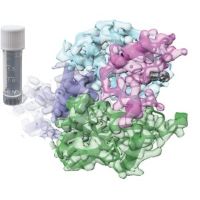Specification
| Description | Recombinant protein from the full-length sequence of Homo sapiens ubiquitin protein ligase E3A (UBE3A), transcript variant 3 (NM_130839). |
| Organism | Homo sapiens (Human) |
| Expression Host | Human Cells |
| Tag Info | His or DYKDDDDK. Please contact us if you need further information or require specific designed tag. |
| Purity | Greater than 90% by SDS-PAGE gel |
| Uniprot ID | Q05086 |
| Entry Name | UBE3A_HUMAN |
| Gene Names | UBE3A E6AP EPVE6AP HPVE6A |
| Alternative Gene Names | E6AP EPVE6AP HPVE6A |
| Alternative Protein Names | Ubiquitin-protein ligase E3A (EC 2.3.2.26) (E6AP ubiquitin-protein ligase) (HECT-type ubiquitin transferase E3A) (Human papillomavirus E6-associated protein) (Oncogenic protein-associated protein E6-AP) (Renal carcinoma antigen NY-REN-54) |
| Application | Antigens, Western, ELISA and other in vitro binding or in vivo functional assays, and protein-protein interaction studies; For research & development use only! |
| Buffer | Purified protein formulated in a sterile solution of PBS buffer, pH7.2, without any preservatives |
| Endotoxin | Endotoxin level is < 0.1 ng/µg of protein (<1EU /µg) |
| Length | 875 |
| Molecular Weight(Da) | 100688 |
| Protein Sequence | (The sequence of expressed protein may have some variation from the sequence shown below. Please contact us for the exact sequence.) MEKLHQCYWKSGEPQSDDIEASRMKRAAAKHLIERYYHQLTEGCGNEACTNEFCASCPTFLRMDNNAAAIKALELYKINAKLCDPHPSKKGASSAYLENSKGAPNNSCSEIKMNKKGARIDFKDVTYLTEEKVYEILELCREREDYSPLIRVIGRVFSSAEALVQSFRKVKQHTKEELKSLQAKDEDKDEDEKEKAACSAAAMEEDSEASSSRIGDSSQGDNNLQKLGPDDVSVDIDAIRRVYTRLLSNEKIETAFLNALVYLSPNVECDLTYHNVYSRDPNYLNLFIIVMENRNLHSPEYLEMALPLFCKAMSKLPLAAQGKLIRLWSKYNADQIRRMMETFQQLITYKVISNEFNSRNLVNDDDAIVAASKCLKMVYYANVVGGEVDTNHNEEDDEEPIPESSELTLQELLGEERRNKKGPRVDPLETELGVKTLDCRKPLIPFEEFINEPLNEVLEMDKDYTFFKVETENKFSFMTCPFILNAVTKNLGLYYDNRIRMYSERRITVLYSLVQGQQLNPYLRLKVRRDHIIDDALVRLEMIAMENPADLKKQLYVEFEGEQGVDEGGVSKEFFQLVVEEIFNPDIGMFTYDESTKLFWFNPSSFETEGQFTLIGIVLGLAIYNNCILDVHFPMVVYRKLMGKKGTFRDLGDSHPVLYQSLKDLLEYEGNVEDDMMITFQISQTDLFGNPMMYDLKENGDKIPITNENRKEFVNLYSDYILNKSVEKQFKAFRRGFHMVTNESPLKYLFRPEEIELLICGSRNLDFQALEETTEYDGGYTRDSVLIREFWEIVHSFTDEQKRLFLQFTTGTDRAPVGGLGKLKMIIAKNGPDTERLPTSHTCFNVLLLPEYSSKEKLKERLLKAITYAKGFGML |
Background
| Function | FUNCTION: E3 ubiquitin-protein ligase which accepts ubiquitin from an E2 ubiquitin-conjugating enzyme in the form of a thioester and transfers it to its substrates (PubMed:10373495, PubMed:16772533, PubMed:19204938, PubMed:19233847, PubMed:19325566, PubMed:19591933, PubMed:22645313, PubMed:24273172, PubMed:24728990). Several substrates have been identified including the ARNTL/BMAL1, ARC, RAD23A and RAD23B, MCM7 (which is involved in DNA replication), annexin A1, the PML tumor suppressor, and the cell cycle regulator CDKN1B (PubMed:10373495, PubMed:19204938, PubMed:19325566, PubMed:19591933, PubMed:22645313, PubMed:24728990). Additionally, may function as a cellular quality control ubiquitin ligase by helping the degradation of the cytoplasmic misfolded proteins (PubMed:19233847). Finally, UBE3A also promotes its own degradation in vivo. Plays an important role in the regulation of the circadian clock: involved in the ubiquitination of the core clock component ARNTL/BMAL1, leading to its proteasomal degradation (PubMed:24728990). Acts as transcriptional coactivator of progesterone receptor PGR upon progesterone hormone activation (PubMed:16772533). Acts as a regulator of synaptic development by mediating ubiquitination and degradation of ARC (By similarity). Synergizes with WBP2 in enhancing PGR activity (PubMed:16772533). {ECO:0000250|UniProtKB:O08759, ECO:0000269|PubMed:10373495, ECO:0000269|PubMed:16772533, ECO:0000269|PubMed:19204938, ECO:0000269|PubMed:19233847, ECO:0000269|PubMed:19325566, ECO:0000269|PubMed:19591933, ECO:0000269|PubMed:22645313, ECO:0000269|PubMed:24273172, ECO:0000269|PubMed:24728990}.; FUNCTION: (Microbial infection) Catalyzes the high-risk human papilloma virus E6-mediated ubiquitination of p53/TP53, contributing to the neoplastic progression of cells infected by these viruses. {ECO:0000269|PubMed:8380895}. |
| Pathway | Protein modification; protein ubiquitination. |
| Protein Families | |
| Tissue Specificity |
QC Data
| Note | Please contact us for QC Data |
| Product Image (Reference Only) |  |

